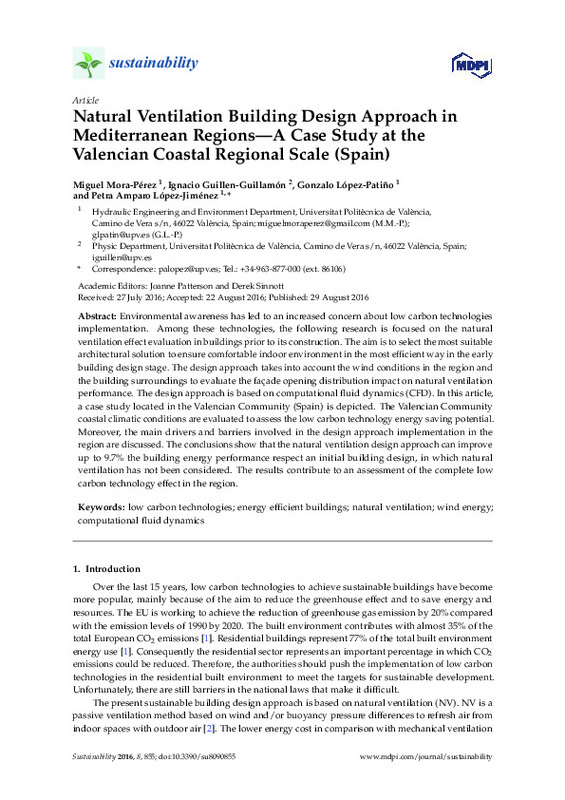JavaScript is disabled for your browser. Some features of this site may not work without it.
Buscar en RiuNet
Listar
Mi cuenta
Estadísticas
Ayuda RiuNet
Admin. UPV
Natural Ventilation Building Design Approach in Mediterranean Regions A Case Study at the Valencian Coastal Regional Scale (Spain)
Mostrar el registro sencillo del ítem
Ficheros en el ítem
| dc.contributor.author | Mora-Pérez, Miguel
|
es_ES |
| dc.contributor.author | Guillén Guillamón, Ignacio Enrique
|
es_ES |
| dc.contributor.author | López-Patiño, Gonzalo
|
es_ES |
| dc.contributor.author | López Jiménez, Petra Amparo
|
es_ES |
| dc.date.accessioned | 2018-07-16T06:43:22Z | |
| dc.date.available | 2018-07-16T06:43:22Z | |
| dc.date.issued | 2016 | es_ES |
| dc.identifier.uri | http://hdl.handle.net/10251/105808 | |
| dc.description.abstract | [EN] Environmental awareness has led to an increased concern about low carbon technologies implementation. Among these technologies, the following research is focused on the natural ventilation effect evaluation in buildings prior to its construction. The aim is to select the most suitable architectural solution to ensure comfortable indoor environment in the most efficient way in the early building design stage. The design approach takes into account the wind conditions in the region and the building surroundings to evaluate the façade opening distribution impact on natural ventilation performance. The design approach is based on computational fluid dynamics (CFD). In this article, a case study located in the Valencian Community (Spain) is depicted. The Valencian Community coastal climatic conditions are evaluated to assess the low carbon technology energy saving potential. Moreover, the main drivers and barriers involved in the design approach implementation in the region are discussed. The conclusions show that the natural ventilation design approach can improve up to 9.7% the building energy performance respect an initial building design, in which natural ventilation has not been considered. The results contribute to an assessment of the complete low carbon technology effect in the region. | es_ES |
| dc.language | Inglés | es_ES |
| dc.publisher | MDPI AG | es_ES |
| dc.relation.ispartof | Sustainability | es_ES |
| dc.rights | Reconocimiento (by) | es_ES |
| dc.subject | Low carbon technologies | es_ES |
| dc.subject | Energy efficient buildings | es_ES |
| dc.subject | Natural ventilation | es_ES |
| dc.subject | Wind energy | es_ES |
| dc.subject | Computational fluid dynamics | es_ES |
| dc.subject.classification | FISICA APLICADA | es_ES |
| dc.subject.classification | MECANICA DE FLUIDOS | es_ES |
| dc.subject.classification | INGENIERIA HIDRAULICA | es_ES |
| dc.title | Natural Ventilation Building Design Approach in Mediterranean Regions A Case Study at the Valencian Coastal Regional Scale (Spain) | es_ES |
| dc.type | Artículo | es_ES |
| dc.identifier.doi | 10.3390/su8090855 | es_ES |
| dc.rights.accessRights | Abierto | es_ES |
| dc.contributor.affiliation | Universitat Politècnica de València. Departamento de Física Aplicada - Departament de Física Aplicada | es_ES |
| dc.contributor.affiliation | Universitat Politècnica de València. Departamento de Ingeniería Hidráulica y Medio Ambiente - Departament d'Enginyeria Hidràulica i Medi Ambient | es_ES |
| dc.description.bibliographicCitation | Mora-Pérez, M.; Guillén Guillamón, IE.; López-Patiño, G.; López Jiménez, PA. (2016). Natural Ventilation Building Design Approach in Mediterranean Regions A Case Study at the Valencian Coastal Regional Scale (Spain). Sustainability. 8(9):1-15. doi:10.3390/su8090855 | es_ES |
| dc.description.accrualMethod | S | es_ES |
| dc.relation.publisherversion | https://doi.org/10.3390/su8090855 | es_ES |
| dc.description.upvformatpinicio | 1 | es_ES |
| dc.description.upvformatpfin | 15 | es_ES |
| dc.type.version | info:eu-repo/semantics/publishedVersion | es_ES |
| dc.description.volume | 8 | es_ES |
| dc.description.issue | 9 | es_ES |
| dc.identifier.eissn | 2071-1050 | es_ES |
| dc.relation.pasarela | S\317119 | es_ES |








